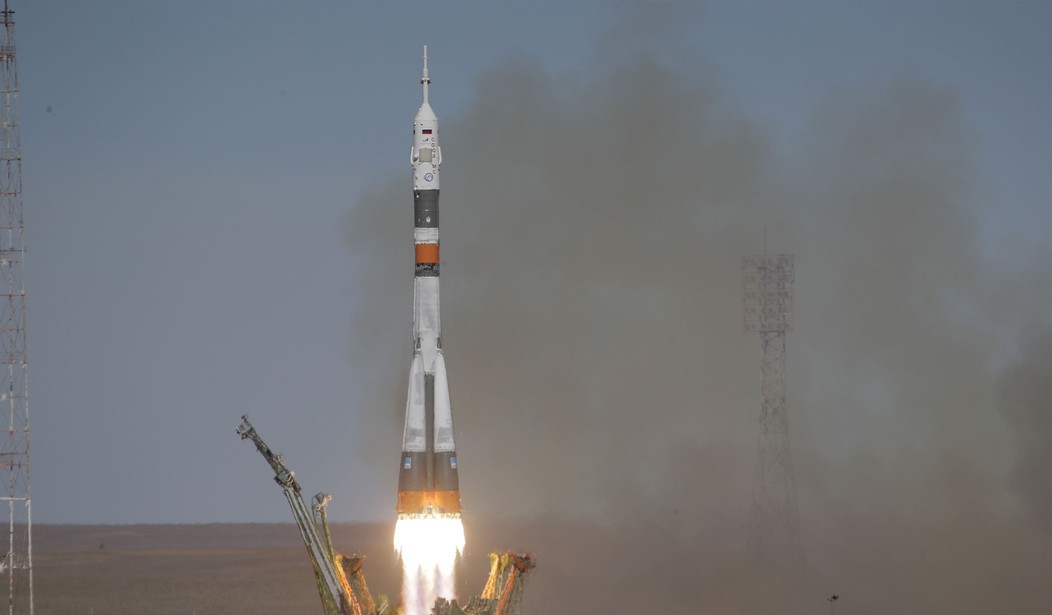U.S. Space Command said that the launch of a Soyuz rocket from Russia's Plesetsk launch site on May 17 was likely a "counterspace weapon capable of attacking other satellites in low Earth orbit," according to Fox News.
The new satellite, designated "Cosmos 2576," is in the same orbit as America's USA 314 satellite. That suggests the Russian satellite has ASAT capabilities.
Russia denies it. But U.S. intelligence knew as long ago as February that Russia was going to deploy a new ASAT weapon in the near future. House Intelligence Committee Chairman Mike Truner warned in February that the committee had "made available to all Members of Congress information concerning a serious national security threat."
That threat was the assumption that Russia had placed a nuclear weapon in space.
That assumption is based on the simple fact that satellites moving at 22,500 MPH are very hard to hit. If you use a nuke to destroy a satellite, a near miss is as good as a hit.
"I don't think we should respond to any fake news from Washington," Russian Deputy Foreign Minister Sergei Ryabkov was quoted as saying by the Interfax news agency.
"The Americans can say whatever they want, but our policy does not change from this," said Ryabkov, adding that Moscow had "always consistently opposed the deployment of strike weapons in low-Earth orbit."
The choice of language was curious. The weapon would not be a "strike" weapon to hit the Earth but rather a space weapon to target satellites.
Related: U.S.-Built Pier in Gaza an Epic Failure
U.S. Space Command said the May launch, which it dates as May 16, included COSMOS 2576, a type of Russian military "inspector" spacecraft that U.S. officials have long said exhibits reckless space behavior.
U.S. intelligence agencies had been expecting the launch of COSMOS 2576 and informed allies of their assessment of the satellite before its deployment in space, according to a U.S. official familiar with the intelligence. The launch also included civilian satellites deployed to different orbits.
COSMOS 2576, as of Tuesday, has not gone near a U.S. satellite, but space analysts observed it to be in the same orbital ring as USA 314, a bus-sized National Reconnaissance Office satellite launched in April 2021.
Russia tried to use the UN as cover when they introduced a resolution in the Security Council, piously calling on all countries to prevent "for all time" the "placement, threat or use of any weapons in outer space," according to Reuters.
The resolution failed, as Moscow knew it would, except Russia is now on the record as opposing the placement of weapons in outer space. They vetoed a similar resolution introduced by the U.S. in April.
"We are here today because Russia seeks to distract global attention from its development of a new satellite carrying a nuclear device," deputy U.S. Ambassador Robert Wood told the Security Council before the vote.
Russia's U.N. Ambassador Vassily Nebenzia claimed he didn't understand what Wood was saying when he accused Russia of launching a nuke into space.
Nebenzia said the Russian draft resolution covered both weapons of mass destruction and all forms of other weapons and was aimed at stopping an arms race in outer space.
But, when pressed by Nebenzia, Wood took issue with language in the draft seeking "a lengthy binding mechanism that cannot be verified," saying, "I've seen this movie before."
The Russian draft had language echoing a 2008 proposal by Moscow and Beijing for a treaty banning "any weapons in outer space" and threats "or use of force against outer space objects," but the diplomatic effort did not find international support.
The U.S. almost certainly has its own ASAT capability. Whether it's already in space is unknown. But you can bet it's on a launch pad somewhere waiting for a crisis before it's sent up.










Join the conversation as a VIP Member